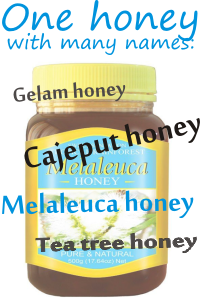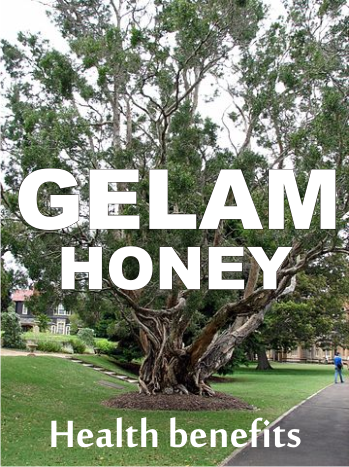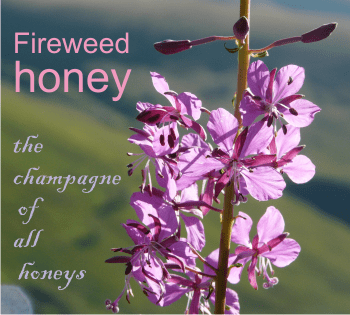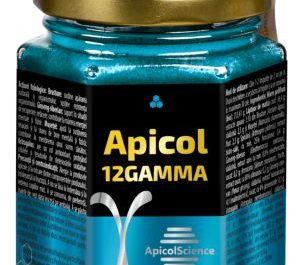What are Gelam Honey’s (aka Melaleuca or Cajeput honey) benefits for our health? How is this that cancer cells commit suicide? What’s in honey that is so bad to them?
Lately, there have been lots of studies on its benefits, but probably the most important activity of honey that was researched was its antiproliferative and apoptosis induction.
Meaning if it heals cancer or not, because this is our most acute concern these days!
Induces apoptosis in cancer cells.
First, what is apoptosis?
Necrosis and Apoptosis are the two ways our cells are dying.
Necrosis happens when the cell is damaged by an external force like:
– poison (yes, our chemotherapy!),
– a bodily injury,
– an infection,
– doesn’t get blood – like in a case of heart attack, stroke or death.
When a cell dies through necrosis, this causes an inflammation, which can trigger further distress or injury within the body.
Apoptosis is suicide. Also known as programmed cell death, a controlled, predictable process. Here is how it’s done: the cell that has been stressed, damaged or triggered by body signals to kill itself, begins to shrink and form blebs. Proteins (called caspases) start to break down the cell’s components. Enzymes break down the nucleus and signals are sent to the macrophages (a special kind of cells, like vacuum cleaners). The cell eventually breaks into smaller parts and the already called macrophages clean up the mess.
When does a cell know it should suicide itself?
1. When cells recognize viruses and gene mutations, they commit suicide to prevent the spreading.
2. When cells are under stress, as may happen when free radicals are on the loose or when a person undergoes radiation.
Signals in the body tell a cell to continue living or not. But this doesn’t always function perfectly, sometimes the wrong cells live and the healthy ones die. These mistakes trigger diseases (or is it the other way around? science doesn’t know.) and disorders in the body. E.G.:
– an increase of apoptosis is met in AIDS, Alzheimer’s and Parkinson’s disease
– a decrease of apoptosis is met in lupus or cancer.
Our scientists are researching on how to control the signals that tell a cell to continue to live or to die. Today’s radiation or anticancer drugs are supposed to trigger apoptosis only in the diseased cells. The bad thing is that this never happens. Healthy cells are killed together with the sick ones.
But guess what! This does happen with honey. Honey is a natural treatment for cancer. After a person takes honey, his sick cells kill themselves. And this is what hundreds of studies are showing: in vivo, in vitro, on animals or in human clinical trials. Products of the hive do have a clear benefit on the human body.
What happens in a cancer cell?
A normal state in our body is maintained by a balance between apoptosis and cell renewal (the birth of new ones). A cancer cell is continuously dividing, causing cellular and organ dysfunction.
Among the population of Asia, liver cancer has a high frequency rate, closely linked to chronic hepatitis B infection. The drugs have failed, and a resistance to them have been found, and side-effects are devastating.
For this reason, most of the studies made on how honey can prevent cancer or how to treat the existent one, are conducted in Asia. The University of Malaysia has published lots of studies, made on different types of honey, especially on Tualang honey, Gelam honey, Manuka honey.
Gelam honey is a local Malaysian honey. What makes this honey a good promising remedy for cancer? Mainly:
– a high content of phenolic compounds which lead to a high level of antibacterial activity
– powerful antioxidant compounds which lead to free radical scavenging.
 From all the superfoods, why was honey chosen for the studies?
From all the superfoods, why was honey chosen for the studies?
First, the food must have a high content of antioxidants. They are known to prevent different diseases, such as cancer, coronary diseases, inflammatory disorders, neurological degeneration, and aging.
Honey is rich in phenolic compounds and other antioxidants like ascorbic acid, amino acids, and proteins. Some phenols and polyphenols found in honey proved to be promising pharmacological agents in the treatment of cancer.
Here are some of them:
caffeic acid (CA), caffeic acid phenyl esters (CAPE), Chrysin (CR), Galangin (GA), Quercetin (QU), Kaempferol (KP), Acacetin (AC), Pinocembrin (PC), Pinobanksin (PB), and Apigenin (AP).
The study “Phenolic acid composition and antioxidant properties of Malaysian honeys.” studied the phenolic acid and flavonoid contents of Malaysian tropical honeys: Tualang, Gelam, and Manuka honey. Among the Malaysian honey samples, Tualang honey had the highest contents of phenolics, flavonoids and DPPH radical-scavenging activities.
In those 3 sample of Malayan honeys, the authors identified:
· 6 phenolic acids: gallic, syringic, benzoic, trans-cinnamic, p-coumaric, and caffeic acids
· 5 flavonoids: catechin, kaempferol, naringenin, luteolin, and apigenin.
The conclusion: Tualang honey is the richest in phenolic acids, and flavonoid compounds, which have strong free radical-scavenging activities.
Studies that show the anti-cancer activity of gelam honey:
• The study “Antiproliferative Activity and Apoptosis Induction by HGelam honey on Liver Cancer Cell Line” by Zakiah Jubri et al., from the National University of Malaysia, and published by the International Journal of Applied Science and Technology, on April 201, was researching the antiproliferative effects of gelam honey on liver cancer, HepG2.
This honey has high polyphenols content that possesses antioxidant and free radical scavenging activity towards preventing cancer and diseases. Gelam honey reduced the proliferation of HepG2 at concentrations of 3% to 70%. Morphological analysis for apoptosis detection using fluorescent microscope under 400X magnification producing typical apoptotic characteristic. It showed that gelam honey has antiproliferative activity towards cancer cell by its ability to induce apoptosis.
Malaysian gelam honey has the ability to reduce
the proliferation rate of liver cancer cells at a low dose
but not affecting the normal liver cells.
• Gelam honey attenuated radiation-induced cell death in human diploid fibroblasts by promoting cell cycle progression and inhibiting apoptosis., by Tengku Ahbrizal Farizal Tengku Ahmad et al. from the Universiti Kebangsaan Malaysia. The aim of this study was to elucidate the role of Gelam honey as a radioprotector in human diploid fibroblast (HDFs) which were exposed to gamma-rays by determining the expression of genes and proteins involved in cell cycle regulation and cell death.
The conclusion: Gelam honey acts a radioprotector against gamma-irradiation by attenuating radiation-induced cell death.
• The antioxidant effect of the Malaysian Gelam honeyon pancreatic hamster cells cultured under hyperglycemicconditions, by Kalaivani Batumalaie et al., published on March 2013.
Type 2 diabetes consists of progressive hyper-glycemia, insulin resistance, and pancreatic ß-cell failure, which could result from glucose toxicity, inflammatory cytokines, and oxidative stress. THe authors of the study investigated the effect of pretreatment with Gelam honey (Melaleuca spp.) and the individual flavonoid components chrysin, luteolin, and quercetin, on the production of reactive oxygen species (ROS), cell viability, lipid perox-idation, and insulin content in hamster pancreatic cells (HIT-T15 cells), cultured under normal and hyperglycemic conditions.
The results: “Data showed that pretreatment with the extract of the Gelam honey and the different favonoid components at the indicated concentration, for 24 h at 37°C, protects ß-cell function from the oxidative damage caused by the ROS, under hyperglycemic state.
The extract from Gelam honey had a protective effect which was significantly higher than the individual flavonoids. This could be due to the additive effect of all the three flavonoids present in the extract, and the phenolic acids such as gallic,ferulic, caffeic, benzoic, and cinnamic acids which areantioxidants.”
• Effects of Gelam and Acacia honey acute administration on some biochemical parameters of Sprague Dawley rats, by Samat S et al., observed the effects of acute administration (14 days) of Gelam honey, a wild harvesting honey and Acacia honey, a beekeeping honey, on male and female Sprague Dawley (SD) rats (a type of rats used in laboratory).
The results suggest that acute consumption of Gelam Honey and Acacia Honey at 2000 mg/kg body weight of male and female Sprague Dawley rats has some discrepancy effects on biochemical parameters but in line with OECD regulation. Gelam honey may have potential in controlling weight gain and triglyceride levels in female rats compared to Acacia honey.
Other studies for further reading:
– Gelam Honey Attenuates Carrageenan-Induced Rat Paw Inflammation via NF-κB Pathway;
– A study on the benefits of gelam honey that showed how gelam honey helps to reverse (or at least slow down) the aging process in rats: Gelam Honey A New Anti-Ageing Supplement?;
– Evaluation of physicochemical and antioxidant properties of sourwood and other Malaysian honeys: a comparison with manuka honey, available for download here: http://journal.chemistrycentral.com/content/pdf/1752-153X-7-138.pdf;
– The Efficacy of Gelam Honey Dressing towards Excisional Wound Healing
All studies’ conclusion: Honey is a functional food with different biological properties such as:
antibacterial (bacteriostatic properties),
anti-inflammatory,
wound and sunburn healing,
antioxidant,
radical scavenging,
antidiabetic,
antimicrobial.
*******************************
References:
http://science.howstuffworks.com/life/cellular-microscopic/apoptosis.htm
http://www.ncbi.nlm.nih.gov/pubmed/19636435
http://www.webmd.com/vitamins-supplements/ingredientmono-457-cajeput%20oil.aspx?activeingredientid=457&activeingredientname=cajeput%20oil
“Melaleuca leucadendra-large2” by Eug – Own work. Licensed under Public Domain via Wikimedia Commons – http://commons.wikimedia.org/wiki/File:Melaleuca_leucadendra-large2.jpg#/media/File:Melaleuca_leucadendra-large2.jpg





Hello,
Thank you, Laura, for such a wonderful website that is helping so many people. 🙂
If you or your readers would like to purchase Gelam Honey from a trustful and reputable source, please see our Gelam, Kelulut, and Tualang honey at FortuneHoney.com
As you know, raw unpasteurized honey is very, very healthy and has been scientifically proven to have anti-cancer qualities.
Fortune Honey is the first and ONLY distributor to bring Tualang Honey, Gelam Honey, and Kelulut Honey directly to North America in the United States.
This was made possible by teaming up with one of the best exotic honey suppliers in the world, Nirwana, of Southeast Asia in Malaysia.
Nirwana Is Our “Queen Bee”
Fortune Honey is honored to have an exclusive relationship with the best and most trusted source of authentic Tualang, Gelam, and Kelulut honey from Southeast Asia. Nirwana is a successful and eco-conscientious entrepreneur who loves the wild. A graduate of the prestigious Imperial College London, she leads teams of specialized honey hunters on foot to travel deep into the pristine jungle to harvest the rarest of honeys on the highest trees in the rainforest. Without her expertise and adherence to best practices, we wouldn’t have the privilege of experiencing this highly-treasured 100% pure gift from nature. Thank you, Nirwana!
Fortune Honey is located in Georgia, “The Peach State” in the Southeastern region of the USA.
Raw. 100% Pure. Unprocessed. Unpasteurized. Extremely Rare. Premium Wild Bee Honey.
The Most Nutritious Honey Available. Radically Superior To “Regular Honey”. Proven Health Benefits More Powerful Than Other High-Quality Honeys.
Made Fresh For You Naturally, By Giant Wild Honey Bees, 300 Feet Above Ground, At The Top Of The Tallest Trees In The World, From The Biologically Diverse 130-Million-Year-Old Ancient Jungle, Of The Most Pristine Tropical Rainforests On The Planet In Asia.
#1 Anti-Aging MUST HAVE Superfood! Jam packed with Vitamins, Antioxidants. Kills bacteria. Reduces Inflammation. Antidiabetic. Anti-tumor. Anti-Cancer.
Thank you for your consideration. Please reach out to us if you have any questions.
Fortune Honey’s Gelam Honey, Tualang Honey, and Kelulut Honey are harvested with love by: East Honey & Herbs Kuala Lumpur KUL, Malaysia ?
Hi,
It sounds indeed fortunate to have met Nirwana and be able to sell their rare products to the world. I encourage people to try them. Thank you for letting us know where can we find them in the USA.
Laura
Hi Laura,
Thanks so much for this post.
My name is Dino and I’m a local beekeeper from Malaysia.
I’m specialised in the stingless beekeeping (Kelulut in local Malay term) industry in Malaysia. New research are being done on Kelulut honey and we have our bees reared in Rainforest environment, acacia environment and also Gelam (Melaleuca) environment. Of course each harvest dependa on what flowers are blossoming.
Kelulut honey is gaining more popularity in Malaysia and hopefully the world because it is sustainable beekeeping at our farms.. Last week there was a novel finding research that Kelulut honey is suitable even for diabetic patients because of the high amount of Trehalulose found in the honey.
So we are really excited about this as well. If you are in Malaysia, pls drop me a note and I will bring you personally to my Kelulut farm for a tour and honey tasting experience.
RegardS
Dino
http://www.dinokelulut.com
Hi Laura,
My dog had a small black tag on the side of his nose & belly. Before I could tie off the belly tag he chewed it off. The tag on his nose he began rubbing it, now its a size of half dollar. Its inflamed, raw, using his nose bumps or rubs it which makes it bleed,( I apply pressure stop bleed. I use Coconut oil to clean & stop bleed, then spray 2ist Century Essential Pet-Liquid Bandage Spray on the sore, cover eyes and nose with cloth.(I read about Wound Care) The sore is at his nose and yesterday found the side of his mouth to corner mouth is enlarged, not hard, I looked in his mouth, lifted the area and he did not seem to mind. I read about the Sourwood Honey, anti-cancer activity of Gelam. No Diagnoses had been made. It is hard to wrap or bandage the area.
He got E-Colli 2015-2016, all gone by use of drug from Vet. The drug was taken off the market for Human Consumption but approved for Vets to use. I had to wear gloves/no contact with my skin cause cancer in Humans. Stopped E-Colli but now what damage did it do.
Like Linda and her daughter with their Lab diagnosed with bone cancer, I want to start my dog on something to kill the cancer cells like Gelam/Sourwood Honey and start with Essential oils but I read to much that I am at a loss but think I need to act like it is cancer, do not what a Vet to cause if the C to spread with Biopsi
Second, he is a rescue, 10yrs old, I took him after he was hit by a car, the previous owner never took care of the accident. He became mine 3 months later. He slipped 4/19, did the splits with back legs and favors left back leg. I read about Bee Venum & honey (A Brand PreMade), cant remember the name.
Please help with recommedations as to where to start, buy, look for what type of honey/mixture, and oils.
Thank you for your help.
Hi Daina,
I’m afraid the vet section is not in my area of expertise. If he does have cancer, there is a need of a complex protocol and you need a naturopath for this. Of course you can research yourself and start a treatment based on your instinct. Bee products are all recommended. Especially propolis. But there are not enough studies and clinical tries (really hard to perform with animals) to indicate a right dosage on similar situations. In vitro lab studies are not relevant enough, because an organism is a complex system and there are more factors that should be taken into consideration.
Anyway, in your shoes, I would try everything, of course, but I would probably want a certain diagnostic first. I’m not saying that knowing it can help the problem. Because it can actually do worse.
Plants can do miracles. That’s true. Honey and all the other products of the hive come from the nectar – the most delicate essence of a plant. But to fight such a serious disease, you need powerful stuff. And essential oils are concentrated power of plants. Focus more on them.
Unfortunately I don’t know about their effect on dogs, as they are different that humans, the connection they have between brain and nose is different and their entire body could react differently. You’ll have to research a lot.
I’m sorry I cannot help you with more. Yet I wish you all the luck and inspiration to find what you need.
Laura
Hi Laura,
Thank you for building such a wonderful, informative website. Great job!
Sunday our daughter’s dog was diagnosed with bone cancer. This type is aggressive, always terminal – so they say. We are not doing chemo.
Currently, we have started her on 1 tablespoon twice a day of black seed oil. We have black raspberry seed oil, black raspberry seed powder, black seed powder and CBD oil on order.
We are increasing her pre and pro-biotics. And her iodine.
I’m not sure if you are familiar, but we are also using Master Mineral Solution throughout the day.
I would like to add in some bee products, but I’ve spent several hours on your site and really still am not sure what to purchase. I realize honey is more preventative, but also is synergistic with other naturals that we are using.
Many of the articles regarding bee products are on their use with chemo or on tissue cancers rather than bone.
We would appreciate your thoughts on best products to incorporate into her protocol.
And for myself, curious which honey has the lowest glycemic impact.
Very kind regards,
Linda
Hi Linda,
First of all I apologize for answering so late, it’s been crazy here. Secondly, congratulation on being so courageous as to not start chemo. I would also give propolis – an amazing product, generally, but I don’t know the dose or form for dogs. Also, please try and find some essential oils, that are fit for dogs and this situation. Always go for the purest form, I personally use DoTerra, but there are others.
And with the risk of being considered loony, I would also add what spiritualists say in this kind of cases: that a profound connection between two souls can facilitate the transfer of all forms of energy from one side to another. Which means that a dog, which is capable of real love, can take over the suffering, the pain, the disease, that affects his/her master. That at a subconscious level the dog took the disease that would have otherwise hit the loved person, sacrificed himself, thus, exonerating his master.
Again, it is at a subconscious level. We people are not capable of seeing the big picture, we don’t know what the other possible alternative could have been, we are not aware of the work of energies/emotions that happen at a deeper level. Spiritualists say (see the Russian Lazarev) that this type of deep connection exists mainly between mother and child (baby). And that whenever a mother goes through a fight, depression, tough period etc, her child will suffer a physical disease. (The same with dogs and even some species of cats)
Starting from here, you could help your dog a lot by simply sending her your feelings of gratitude. For her unconditioned and true love, for making you smile, for loving your daughter, for coming to your houses, for existing there. Feeling love and gratitude in your chest area, literally feeling it, send it to her, imagine it as a light coming into her body, deep into her bone cells. Send her you love and gratitude and wrap it with it. Don’t expect anything in return. Just like a dog would do.
And make this emotion as pure as possible. No other feeling of sadness, sorry, pitty…
In the end, her subconscious will decide if it wants to accept this healing energy or continue its initial mission. (Pretty crazy stuff, I know, I just had to tell you, because no matter if you believe it or not, sending love can only help.)
As for the honey with the lowest glycemic impact, here you can find some: What honey is the best for me?
Also useful: Sugars in honey
All the best!
Laura
I got a reliable source for gelam honey, the seller is a Malaysian lady and she sells her tualang honey to wildely brand.
Best,
Hi Khaled,
Can you share your reliable source information? Would love to put in an order.
Thanks.
melaleuca how compares to manuka in regards its anti cancer properties ?
Hi,
There are not that many studies on manuka honey’s anticancer properties. More on its antibacterial properties. On this regard, there are some comparisons with other honeys and the conclusions say there are some bacteria strings that respond better to manuka and some that respond better to other honeys.
It’s a difficult research, because opposed to synthetic drug, which are always the same, honey is never the same. It depends on geographic area, weather and time of harvest and time of consumption (they change in time) so even if a certain batch proved to be effective on a certain bacterium, this doesn’t guarantee the effect will be the same for all other batches. Essential oils are more stable in this regard.
But as I said before, in all conditions, honey (all raw honey) is preventative more than curative.
General comparisons cannot be done between manuka and all the other honeys for all microbes. It’s easier to search starting from a certain bacterium that you know and then search to see what type of honey can kill it more efficiently.
Laura
melaleuca how compares to manuka in regards its antibacterial properties ?
How much gelam honey would you need to take per day for it to work?
The doses used in this study, were of 2000 mg honey/kg body weight. Per day. So, 2g/kg bw. A tablespoon has 21 g honey. If you have 60 kg, you need 120 g of honey, almost 6 tablespoons per day.
Laura
Really good job. Thank you very much for your post:-). Best regards!
How can I obtain Gelam honey? I am British but live in France.
Where to buy Gelam Honey, Please?
Unfortunately I don’t know a trustful source of gelam (melaleuca) honey. From what I’ve seen on the online, there are some shops selling it like here, or here, but I don’t know if they sell worldwide, or if they are trustful. Or here.
My advice is to ask for details, send emails, check Facebook – some local beekeepers use this cheap form of advertising to sell their products. And gelam/melaleuca honey surely is worth all this trouble.
I hope some day we will be able to find it on more reliable and popular online shops.
Laura